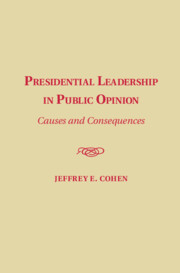Book contents
- Frontmatter
- Contents
- Figures
- Tables
- Acknowledgments
- 1 The Many Meanings of Presidential Leadership
- 2 Evidence of the Public Demand for Presidential Leadership
- 3 Congressional Sources of the President's Leadership Image
- 4 Success in Congress and Perceptions of Presidential Strength
- 5 Presidential Representation and Public Opinion
- 6 Presidential Leadership and Presidential Elections
- 7 Perceptions of Presidential Leadership, Trust in Government, and Attitudes toward Congress
- 8 Presidential Leadership, Public Opinion, and American Democracy
- Sources
- Index
3 - Congressional Sources of the President's Leadership Image
Published online by Cambridge University Press: 05 May 2015
- Frontmatter
- Contents
- Figures
- Tables
- Acknowledgments
- 1 The Many Meanings of Presidential Leadership
- 2 Evidence of the Public Demand for Presidential Leadership
- 3 Congressional Sources of the President's Leadership Image
- 4 Success in Congress and Perceptions of Presidential Strength
- 5 Presidential Representation and Public Opinion
- 6 Presidential Leadership and Presidential Elections
- 7 Perceptions of Presidential Leadership, Trust in Government, and Attitudes toward Congress
- 8 Presidential Leadership, Public Opinion, and American Democracy
- Sources
- Index
Summary
The theory of public perceptions of presidential leadership raises three questions: (1) What do voters mean when they say a president is a good and/or effective leader? (2) What factors influence whether voters think the president is a good leader? (3) What are the implications of these public perceptions on the president and the larger political system?
The theory assumes that voters define presidential leadership in representational and strength terms. Chapter Two presented evidence in support of this assumption. The theory also suggests that three factors – projection, presidential personality, and presidential performance – will affect whether voters think the president is both representative and strong. These pages focus on presidential performance and, in particular, relations with Congress. The contention here is that attributes of the congressional environment, especially party control and polarization, affect the kinds of positions presidents take on roll calls and presidential success on those votes.
The positions presidents take on roll calls before Congress tell us whether the president is a liberal, moderate, or conservative. From this location, we get a sense of how representative a president is, at least in a collective sense. Because voters in general and the median voter in particular tend to be moderate, the collective policy distance between presidents and voters is minimized when the president is also moderate. Policy moderation improves the quality of collective representation from presidents.
But in selecting where to locate on policy debates, presidents do not only take into account how well they represent voters. They also ask whether their side will prevail or not on congressional roll calls. Presidents care about whether their side wins or loses on roll calls. Winning allows the implementation of policies that presidents find desirable (Beckmann 2010; Cohen 2012). But winning may also affect the president's reputation for being strong in so far as victories on congressional roll calls lead voters to think of the president as strong, while loses lead them to view the president as weak.
- Type
- Chapter
- Information
- Presidential Leadership in Public OpinionCauses and Consequences, pp. 34 - 62Publisher: Cambridge University PressPrint publication year: 2015

